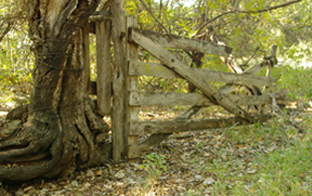
In 1942 C. L. Browning, a general contractor in San Antonio, purchased the 977-acre Hill Country property subsequently known as the Browning Ranch. During the first twenty years of the Browning family’s weekend and summertime life on the property, the raising of cattle and sheep was overseen by ranch foreman Anton Naumann. Nell Naumann, his wife, tended a vegetable garden and a peach orchard, and the four Naumann daughters helped with such chores as feeding hogs, milking cows, and collecting eggs. Although Mr. Browning built the gravel roads that are used today by trucks and other motor vehicles, in those days horses were the principal means of transportation around the ranch. The barn, with its hay loft, tack room, and feed and milking stalls, was an active place and a popular attraction for children.

Cypress-wood gate hangs at the base of an old Texas walnut tree (Juglans microcarpa).
In 1992, upon the death of her mother, Betsy Rogers inherited the Browning Ranch. Between 1992 and 2001, she operated the ranch house as a bed-and-breakfast accommodation and leased grazing rights on the ranch’s pastures to a cattle owner. In 2001, inspired by the work that had been done to reclaim the nearby Bamberger Ranch Preserve as a model of sound land stewardship and environmental preservation practices, Ted and Betsy Rogers decided to develop a similar mission-focused use for their ranch. To pursue their mission, in 2002 they hired Scott Gardner, an environmental scientist, as ranch manager and coordinator of all collaborative projects undertaken on the ranch.
